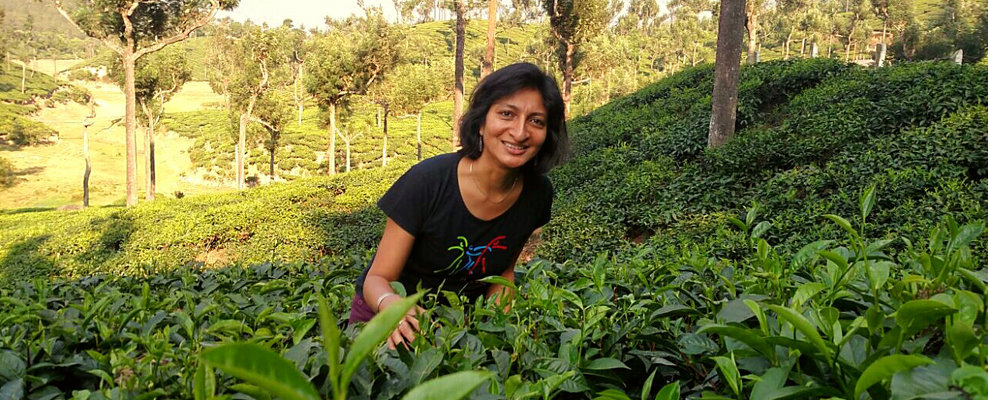Fixing myself a pot of lovely green mint tea on a hot May afternoon, I sit down to recount my experience of Munnar and in particular of my visit to its tea museum and factory.
It took up most of our day just reaching Munnar as we drove up from Thekaddy after breakfast. Enroute, there were the standard coconut water stops besides one unusual ‘sight-seeing’ stop. ‘Sight-seeing’ as the term goes, is any stop en route a journey, which essentially promises you a good view and tends to be a tourist attraction. This one was called Ramakalmeddu and was right at Kerala border, flanked by a solitary shop whose board read, ‘Kerala’s Last Shop’. A ticket allowed us to climb up a steep hill, at the end of which was perched a large family statue of man with his wife, son and a pet rooster. Not much could be ascertained about the significance of the statue, except that it symbolised the local tribesmen and their family spirit. A panoramic view of the countryside along with a welcome breeze made it worth the climb.
Towards the evening, as we started getting closer to Munnar, the temperature started dipping, windows were rolled down and the mobile phones began to go into camera mode. Cutting through winding roads and tea plantations, we reached Munnar by evening, just in time to watch the sun go down and stars light up the sky.
Named after the confluence of three rivers, Mudrapuzha, Nallathanni and Kundala, Munnar is a charming hill station, famous for its wild life sanctuaries, lakes and most importantly, for tea which was brought to the town by the British way back in the late 1800’s. We begin the next day by a visit to the famous Kanan Devan Tea Museum and Factory. Instantly old world, the establishment helps you trace and understand the journey of how tea came to be grown in these lands, thanks to a Concession Deed that was acquired by Turner and Munro in 1879 resulting in the very first plantation in the Parvathy Estate in 1880. A special documentary titled ‘New Roads, Old Mountains’ inducts you into the history of the estate before you move into the factory area for a stage by stage demonstration of how a leaf turns into the beverage that we all take delight in.

Post the factory visit some of us opt for a tea tasting session, conducted by an authorised factory guide who introduces himself as Prince. We move towards a small but well lit room, where row upon row of white bowls and cups as well as tea leaves of a variety of shades greet us. All along the walls are posters on tea: ‘How to make tea’, ‘Types of tea’, ‘Tea terminology’ and so on.
Prince has a fresh tea leaf in hand and begins by telling us about white, green and black tea. Only the topmost tender single bud goes into the making of white tea, whereas that along with the second tender leaf constitutes green tea. The entire leaf taken together would yield black tea.
He then explains that the ubiquitous CTC (crush, tear, curl) tea goes through five stages: withering, cutting, oxidation, drying and grading. Withering which is done after harvesting the crop is the most time consuming process. After this stage that the leaf begins to smell like tea. Post oxidation, the tea is still slightly wet and is dried at 104° celsius, after which it is separated from any waste material in it. The final stage involves grading or filtering of the tea: Black is graded into 6 types whereas Green into 3; the first grade is called Orange Pekoe because of its color and the last is called dust. A useful tip that he shares with us is, the lighter the color of the tea the more flavorsome it is likely to be and vice versa. Orange Pekoe therefore is the lightest in the black variety and dust is the darkest.
White tea is by far the most expensive tea, followed by green and then black. Prince explains that this is because of the ratio of 4:1 that is followed; it takes 4kg of leaves to give us 1 kg of tea. One kg of white tea therefore comes only after collecting 4 kg of a single light bud!
Kanan Devan Hills which is now mostly run by the Tatas has 26 tea estates and 30 factories, with each one producing 8 tonnes of tea per month! Some of their estates are marked out just for the whites and greens whereas others produce all varieties. Needless to say, after the elaborate demonstration and the factory tour, we can’t wait to pick up some of their choicest teas. I go for one of their leading brands called ‘Ripple’ which comes in Green as well as Black types. The verdict: it’s a winner!
